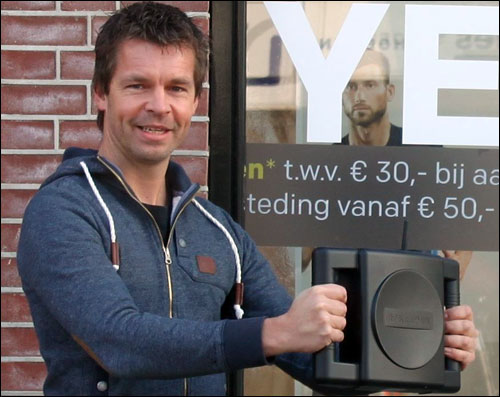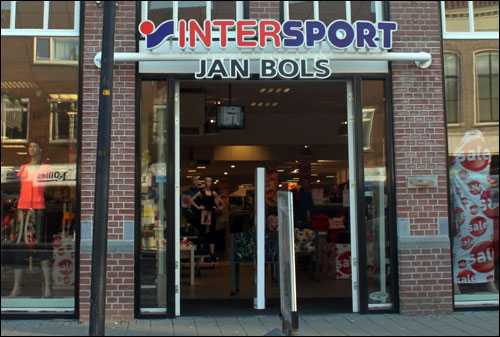Intersport Jan Bols, an athletic equipment and clothing store located in Hoogeveen, the Netherlands, reports that it has boosted sales and decreased inventory-tracking costs via a radio frequency identification solution that tracks approximately 10,000 items storewide, from the back room to the point of sale (POS). Based on the results of a two-month pilot at that store, Intersport International Corp., based in Switzerland, is now deploying the technology at 10 additional Intersport locations throughout the Netherlands.
The solution was provided by retail loss prevention company Cross Point, with RFID technology from Chainlane, using the RFID firm’s Plug & Play RFID Solution. With the technology in place, Intersport JB can now conduct a full inventory count weekly, as well as ensure that all goods are stocked on storefront displays, thereby increasing sales.
The solution consists of Cross Point’s electronic article surveillance (EAS) gates, as well as Chainlane desktop and handheld readers, RFID software, and Chainlane reusable EAS hard tags attached to each item that combine RFID with built-in acousto-magnetic EAS technology.
Intersport International Corp. operates more than 5,400 stores worldwide, in 42 countries. Thus, tracking inventory can be a complex task, says Alexander Bols, Intersport JB’s general manager. Each store has a different product mix designed for that location’s specific clientele, and there is little room for inventory inaccuracy. “Intersport stores rely on accurate stock replenishment to maximize profit,” he states.
In seeking a solution, Intersport JB researched several RFID solutions, ultimately selecting the Cross Point system with Chainlane technology because, Bols explains, the two providers “were able to demonstrate a working solution at our store.” The Intersport JB store already had Cross Point EAS gates installed at its entranceway, and it sought a solution by which a single tag could be used to provide EAS security and RFID tracking. “We didn’t want to compromise on theft prevention or spend money on replacing our gates,” he says, referring to the Intersport JB store.
Chainlane provided its EAS hard tag with a built-in EPC Gen 2 passive ultrahigh-frequency (UHF) RFID inlay (the T1006 Dual AM RFID Apparel Tag), as well as its RFID readers (the Stocktaking Reader SR4002, the POS Detacher Reader TD5002 and the Commissioning Reader AK6001). Intersport JB began testing the technology in November 2013, conducting weekly store counts of its inventory, comparing the results against the manual counts and inventory data in the retailer’s existing management software.
Intersport JB examined the entire solution workflow between November and December, according to Amir Ben-Assa, Chainlane’s VP of marketing and business development. During that time, he says, the store attached the RFID-enabled EAS hard tags to goods within its back room, while Chainlane software collected read data every time the tags were interrogated by RFID readers at various points throughout the site. It uploaded all that information to the store’s existing inventory-management or POS software. Intersport also installed an RFID reader and an EAS tag detacher at the point of sale, in order to provide faster customer checkout. “The readers are designed and manufactured by Chainlane to fully answer the requirements of fashion retail chains,” Ben-Assa says.
During the two-month pilot, the store found that a single employee using Chainlane’s Stocktaking handheld required less than 30 minutes to perform an inventory count with an accuracy of more than 99 percent. It also found that sales increased, since goods were more reliably displayed on the sales floor. Inventory counts are mostly accomplished on the sales floor, where the bulk of the 10,000 items onsite are located.
Goods—such as apparel, footwear and backpacks—arrive at Intersport JB stores from multiple suppliers, so the retailer has opted to have its own staff attach the Chainlane RFID-EAS tags in the back room, as those items are received. Workers attach a tag to each product, read that tag using a desktop Chainlane Commissioning Reader, and link the item to stock-keeping unit (SKU) data indicating, for example, the product’s type, size and color. That data is then forwarded to the retailer’s inventory-management software.
Merchandise can then be placed on display in the storefront as needed. Weekly, a single employee carries an Chainlane Stocktaking handheld reader through the store to interrogate the tags of all items. The collected ID numbers are linked to SKU data in the Plug & Play RFID Solution software, and are forwarded to Intersport JB’s own software to update inventory data. Intersport JB can then determine which goods need to be replenished.
Upon purchasing an item from the store, a customer places the item on the sales counter, where a built-in Chainlane RFID POS Detacher Reader capture’s the tag ID number and forwards data about the product being purchased to the Intersport software, which can then update the inventory count. The POS reader comes with an Chainlane tag-detacher that the sales associate uses to remove the tag so that the product can pass through the EAS gate without triggering an alarm.
An employee at Intersport JB, equipped with a Chainlane Stocktaking handheld, conducts an inventory check every Monday, after which the retailer places replenishment orders based on that inventory update. Other Intersport stores deploying the technology will employ a similar procedure.
“The key issue is that we started using it immediately,” Bols says, “and we did not have to change our working procedures too much.” Workers found the readers fairly simple to use, he reports. “In addition, the customer checkout process at the point of sale was improved. We have only one till and it is getting busy, especially during the weekends.” With the RFID system, he explains, the checkout process is quicker and more accurate, since the tags of all the items placed on the RFID-enabled counter are read instantly, and the POS system can then immediately provide the customer with transaction details, including the total cost. Scanning each item with a bar-code scanner is less efficient, he notes.



